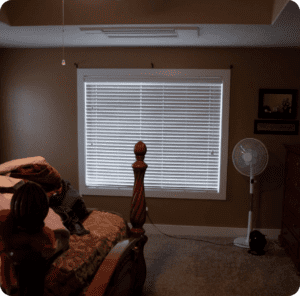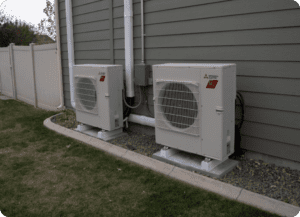Problem: The forced-air HVAC system in this Nampa, ID home left hot and cold spots in various rooms. It was very noisy and expensive.
Solution: Installed a multi-zone mini split. Now, each room gets the exact treatment it needs. And, the system is quieter and more comfortable.
Read More: How Much Does A Mini Split Cost In And Around Boise Metro?
 This Nampa, ID family loved their home — but not their heating and cooling system. The forced-air furnace and AC was loud, inefficient, and couldn’t keep every room at the temperatures they wanted.
This Nampa, ID family loved their home — but not their heating and cooling system. The forced-air furnace and AC was loud, inefficient, and couldn’t keep every room at the temperatures they wanted.
And, with everyone home all the time — both parents work from home and their son is home-schooled — these problems were always noticeable.
After hours of research and interviewing conventional HVAC contractors, our homeowners decided to replace their forced-air gas furnace and central air with a ductless mini split system. They liked the idea of customizing the temperature in each room. And, not dealing with the limitations of ductwork and vents.
We met with the couple, inspected the home, and talked about why they wanted to go with mini splits. Even though they’d learned a lot on their own, there were still plenty of questions for us to answer. Once they were ready, we sat down and designed a customized system that would meet their specific needs.
And all that hard work, both on our part and the homeowners’ research paid off! Now, their home is more comfortable, quiet, and energy-efficient than ever before.
In this case study, we’ll explore:
- HVAC Problems In A Newer Home
- Mini Split Benefits
- Installing A Mini Split In A 2,500-Square Foot Home
- Mini Split Installations In Nampa, ID
And, if you’d like to learn about how a mini split can transform your Boise Metro or Valley County home, click below to download our free product guide. Or, call Snowflake Air at (208) 205-9078 for a free consultation.
HVAC Problems In A Newer Home
Our homeowners’ concerns were common for people in houses built over the last 20 or 30 years: the plumbing and HVAC contractors are the last in line. That means they have to work around existing structures to run lines. As a result, the systems aren’t optimized for best performance.
That’s why this home suffered from hot and cold spots: The ductwork has to run way too far from the furnace and AC to reach the furthest rooms.
The system loses pressure along the way, so there wasn’t a lot of air coming through all the vents. Plus, you’d hear the air rushing through and even the ductwork banging behind the walls on the first floor.
Salvaging the forced-air system would be tough at best. Someone would have to rip through all the walls and restructure everything. It’s a huge expense and invasive work.
A mini split, the family discovered, could do the job much better — and ot require all the demolish and construction.
Instead of using ductwork, these systems have air handlers mounted on the walls in each room. They connect to heat pumps outside using a set of flexible lines that carry coolant from the outdoor units to indoor units.
This way, the lines run behind the walls like electrical wires. There’s no major work needed on the house.
Mini Split Benefits
 The benefits to this mini split didn’t stop with the easy installation.
The benefits to this mini split didn’t stop with the easy installation.
“Constant Heat, Constant Cool”
The new system offers, as this homeowner put it, “constant heat or constant cool.”
There’s no temperature fluctuation like you get with a conventional furnace. Instead, the heat pump maintains the temperature to within a degree of the thermostat settings all the time.
It’s also comfortable heating and cooling! Even with the air handlers on each wall, the family never feels hot or cold air blowing on their face. Instead, the indoor units are whisper-quiet, out-of-the-way, and treat the room without any rushes of forced air.
Customized Comfort
Since each handler has a built-in thermostat, our Nampa, ID family can set the temperature in each room separately. That especially came in handy for the home office.
With our couple working from home for years, their workspace included multiple computers and servers. It got hotter there than anywhere in the house.
With their old system, the only way to cool it off was by craning the AC. That meant the rest of the house was too cold. And, they used way more electricity than they preferred.
Now, the air handler in the office can add more cooling to that zone without affecting the rest of the house.
Installing A Mini Split In A 2,500-Square Foot Home
 Overhauling the HVAC system in a 2,500-foot square home was a big job. But, we still got it done within a week. And, we did it without disturbing the workday or homeschooling sessions.
Overhauling the HVAC system in a 2,500-foot square home was a big job. But, we still got it done within a week. And, we did it without disturbing the workday or homeschooling sessions.
We used two heat pumps to cover the entire house. One outdoor unit fed the air handlers in each room on the first floor and some on the second.
The other heat pump led to an air handler in the attic. We then ran short-ducted units to a few of the rooms from there. And, we added returns above the doors on the second-floor rooms for better circulation.
When we were done, the family was impressed not only by the work but also by the workers. “They were courteous, professional, and really treated our home like it was their own,” was the exact comment we received.
Read More: Rebates and Financing For Mini Splits In And Around Boise Metro
Mini Split Installations In Nampa, ID
Do you think your Treasure Valley home isn’t as comfortable as it should be? If so, we can help! As a Mitsubishi Elite Diamond Dealer, we’re experts when it comes to mini split installations in Nampa, ID, and across the Boise Metro Area. Call us at (208) 205-9078 or click below for a free consultation with mini split installers serving Nampa, ID.




